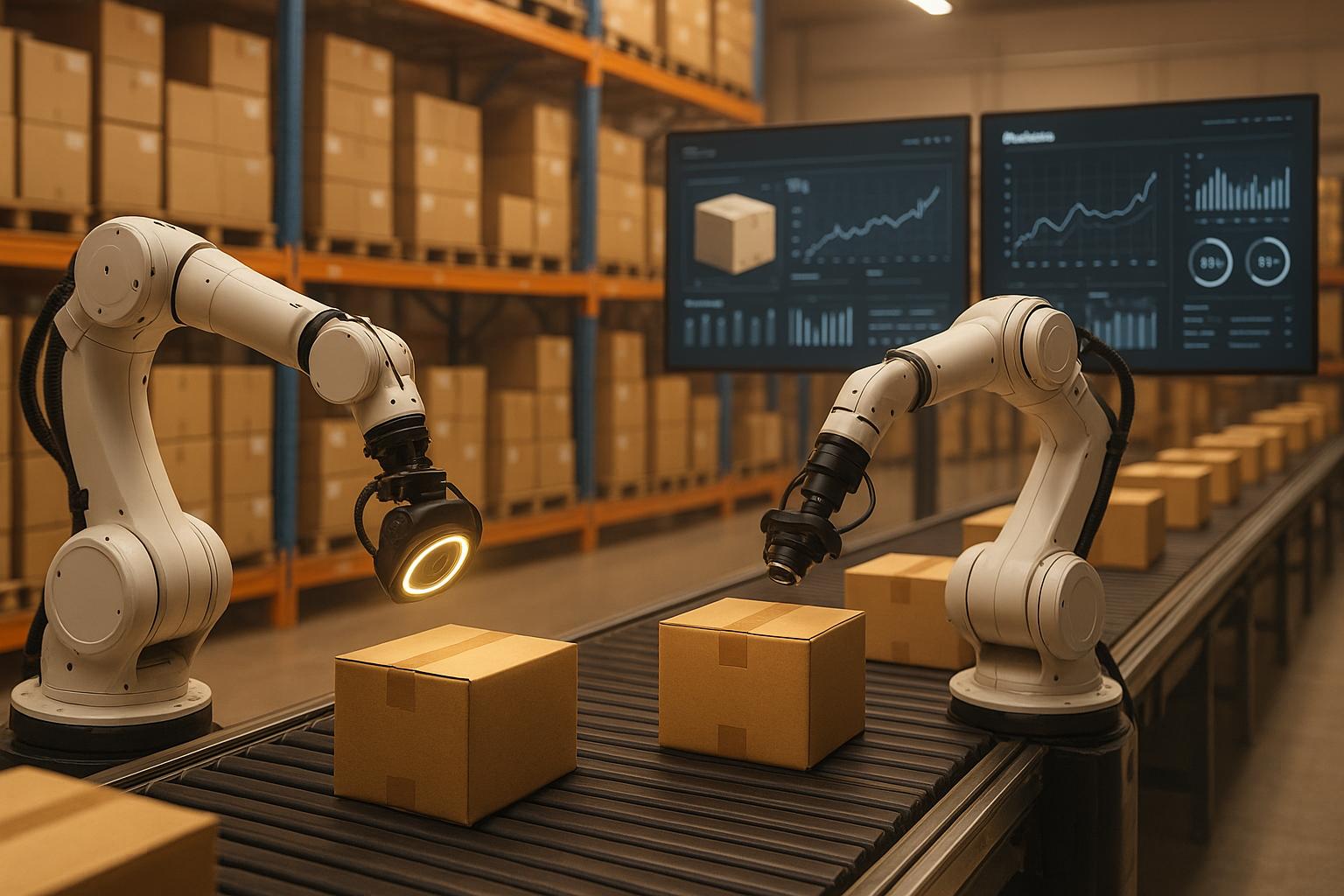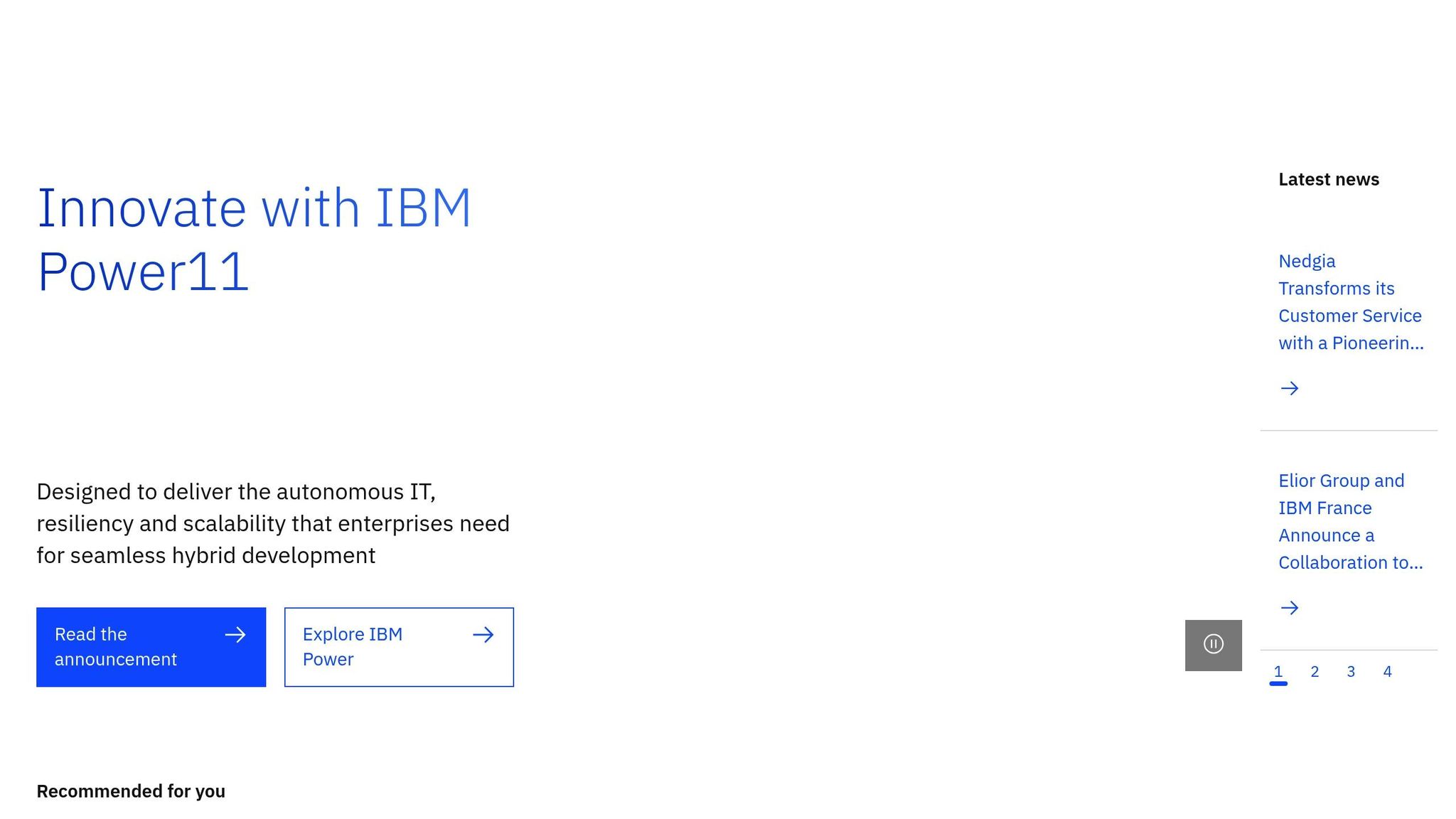
AI is transforming supply chain quality control, shifting from manual inspections to real-time monitoring and predictive analytics. Companies like Amazon, BMW, and IBM are leveraging AI to reduce costs, improve efficiency, and ensure product quality.
Key takeaways:
AI systems minimize errors, reduce waste, and improve decision-making, but challenges remain: high implementation costs, data quality issues, and workforce adaptation. Companies investing in AI now are positioning themselves for long-term success in supply chain management.

Amazon showcases how AI can revolutionize supply chain quality control on a massive scale. The retail giant has seamlessly integrated AI into its operations, tackling everything from predicting customer demand to ensuring damaged goods never make it to customers' doorsteps. This system handles millions of products worldwide, showcasing the power of AI in managing complex logistics.
Amazon's AI systems process enormous amounts of data daily. For instance, during Cyber Monday 2023, the company accurately forecasted demand for 400 million products. This precision allows Amazon to strategically position its inventory, cutting down delivery times while lowering storage costs. Let’s take a closer look at how Amazon uses AI to enhance forecasting and inspection processes.
Amazon's demand forecasting system stands as one of the most advanced in supply chain management. It analyzes diverse data sources - like sales history, seasonal trends, weather conditions, and local events - to predict future demand with impressive accuracy. In 2020 alone, machine learning saved Amazon $1.6 billion, reduced stockouts by 35%, cut carrying costs by 10–15%, and improved customer satisfaction by 20–25%. During the global chip shortage in 2024, Amazon’s AI-driven inventory system minimized production losses by 15% compared to competitors and reduced inventory turnover time by 20%, significantly improving operational efficiency.
"Our goal is to have the right product, in the right place, at the right time, and our predictive inventory system helps us achieve that goal."
– Jeff Wilke, Amazon's CEO of Worldwide Consumer
Amazon's robotic inventory management system, Sequoia, further streamlines operations by identifying and storing inventory 75% faster than traditional methods. This becomes especially critical during peak holiday seasons, where delivery stations handle upwards of 110,000 packages daily - nearly double their usual volume.
Beyond forecasting, Amazon employs AI to ensure product quality through cutting-edge inspection systems. In July 2023, Amazon Fulfillment Technologies in Berlin introduced AI tools capable of detecting and flagging defects before shipment. These systems use computer vision to scan items as they move through warehouses, while machine learning models identify subtle patterns to improve damage detection over time. This AI-driven process is three times more effective than manual inspections, with plans to scan over 40 million products monthly across North America and Europe.
Robotic solutions, such as the Sparrow arm, work alongside AI-powered cameras and sensors to further enhance accuracy.
"These models are helpful, but sometimes, they get fooled. If that happens, we receive immediate feedback from operations employees in Amazon's fulfillment network. Our damage experts directly teach the AI how to make better decisions in the future. It is this collaboration between humans and machines that leads to much better results for our customers."
– Christoph Schwerdtfeger, Applied Science Manager at Amazon Fulfillment Technologies
Amazon's AI efforts also extend to delivery optimization. In October 2024, its Wellspring system mapped over 2.8 million apartment addresses to their corresponding buildings across more than 14,000 complexes. It also identified convenient parking spots at 4 million addresses, ensuring smoother deliveries and reducing the risk of product damage.

BMW Group showcases how AI can streamline the intricate operations of automotive supply chains, particularly in logistics and quality control. Managing 30 million parts daily from 1,800 suppliers across 31 factories while producing 10,000 vehicles with diverse models is no small feat. Since 2018, BMW has integrated AI into its processes, focusing on intelligent robotics, advanced data analytics, and logistics simulations, emphasizing collaboration between humans and AI rather than replacement.
BMW is transforming its logistics using a cloud-native SAP system and cutting-edge robotics. The company is standardizing and automating component workflows across all production sites. By the end of 2025, four facilities will operate on this advanced digital logistics platform, following successful rollouts at the MINI plant in Oxford and the Regensburg facility.
AI-powered 3D scans and adaptive robotics help BMW design virtual layout plans that optimize material flow in real time. Jürgen Maidl, Head of Logistics, highlights the importance of this collaboration:
"The use of high-end AI and visualization technologies to redesign our logistics is revolutionary. Our collaboration with NVIDIA is allowing us to develop state-of-the-art Industry 4.0 technologies. With this high-end technology, we can further optimize our logistics innovations and processes. Combining our innovations with NVIDIA's high-performance technology is a huge step forward."
BMW's AI-driven process intelligence tracks every transaction across its global supply chain, enabling quick responses to supply chain disruptions or changes in demand. For example, at the San Luis Potosí plant in Mexico, a digital control center implemented in November 2022 uses AI algorithms to monitor inbound shipments with 99% accuracy. This has cut the monthly rental costs for returnable containers from €120,000 to under €30,000.
In addition to logistics, BMW has leveraged predictive analytics to enhance quality assurance. AI-powered cameras are deployed at various production stages to identify defects that might escape human inspectors. At the BMW Group Plant Regensburg, the "GenAI4Q" pilot project, launched in April 2025, uses real-time production data to create tailored inspection catalogs for the roughly 1,400 vehicles produced daily. Rüdiger Römich, responsible for Test Floor and Finish in Regensburg's vehicle assembly, explains:
"Our AI tool generates an individual inspection catalogue for each specific customer vehicle."
The results are impressive: a 30% drop in defect rates within the first year at a European plant and a 15% boost in customer satisfaction regarding product reliability in 2022. Manual inspection time has been cut by half, and the time needed to implement AI automation in quality assurance has decreased by over two-thirds.
BMW has also introduced over 1,100 business process automations through its citizen developer program. Using DGX systems, data scientists have seen an 8X increase in productivity, enabling multiple training sessions simultaneously and accelerating innovation throughout the organization.

IBM has taken a groundbreaking step in supply chain quality control by integrating artificial intelligence with blockchain technology. This combination creates a seamless system that prioritizes transparency and ensures data accuracy. Through its cognitive supply chain initiative, IBM has shifted quality assurance from being reactive to a more proactive and intelligent process.
The results? IBM reports $388 million in savings, thanks to lower inventory costs, streamlined shipping, and faster decision-making. Processing times have also been significantly reduced.
At the heart of IBM's approach is a trusted ledger that allows all supply chain participants to input and review data, ensuring an unbroken chain of trust. Blockchain secures the data, while AI predicts potential quality issues. Smart contracts automate responses based on predefined conditions, providing near real-time operational insights. This setup minimizes human error and slashes the time required to tackle quality concerns.
Ron Castro, Vice President of IBM Supply Chain, highlights the system's capabilities:
"In the IBM cognitive supply chain, anyone can access the data, depending on their authority. It's a real-time, single view of the truth, providing immediate insights for faster market response."
The system also features natural language processing, enabling users to query complex supply chain data without needing expertise in older systems or ERP platforms. This accessibility empowers quality control teams to quickly gain insights and recommendations, speeding up responses to issues. For example, tasks like mitigating part shortages, which previously took four to six hours per part, can now be completed in minutes - or even seconds.
This integration is especially impactful for industries that operate under strict regulatory requirements.
IBM’s integrated approach is particularly effective in industries with stringent regulations, such as pharmaceuticals and food, where compliance and safety are critical. Consider this: in some regions, 70% of drugs in the supply chain are counterfeit. A robust tracking system is essential to address such challenges and protect public health.
Pharmaceutical Traceability: In June 2019, IBM collaborated with KPMG, Merck, and Walmart on an FDA pilot program to create a shared blockchain network for tracking prescription products in real-time. This initiative aimed to reduce tracking times, improve data accuracy, and ensure product integrity, including monitoring temperature control.
Mark Treshock, IBM Global Solutions Leader for Blockchain in Healthcare & Life Sciences, explains:
"Blockchain has the potential to transform how pharmaceutical data is controlled, managed, shared and acted upon throughout the lifetime history of a drug."
IBM’s technology also powers the National Association of Boards of Pharmacy’s (NABP) Pulse platform. This digital tool enhances supply chain visibility by tracking and sharing prescription drug ownership records, supporting compliance with the Drug Supply Chain Security Act (DSCSA).
Food Safety Revolution: IBM Food Trust has revolutionized food traceability, reducing the time it takes to track mangoes from farm to store to just 2.2 seconds. This level of speed is critical during foodborne illness outbreaks. By cutting down on paperwork, the solution helps prevent up to 7% of food-related costs tied to documentation alone.
In 2020, IBM partnered with Golden State Foods (GSF), which manages a fleet of 1,000 trucks making over 25,000 weekly deliveries. By combining blockchain with IoT data like weather, traffic, and telematics, IBM’s system improved fleet operations and ensured on-time deliveries while maintaining food safety standards.
Bjorn Kutz, Program Director for Watson IoT and Blockchain, underscores the value of this approach:
"Blockchain establishes a trusted shared environment for all transactions, providing permissioned access for all verified partners. It's a secure solution that simply and quickly tracks products and transactions with visibility to the different parties throughout the chain."
Building on various case studies, it’s clear that AI brings both significant advantages and notable hurdles to supply chain quality control. While the benefits are transformative, implementing AI is not without its complexities.
One of the standout advantages is enhanced efficiency and accuracy. Amazon's Project P.I. is a prime example - tasks that once required five employees performing six-point visual inspections are now automated using generative AI and computer vision. This shift has led to a 75% increase in speed across logistics operations. The system identifies defects and verifies specifications like size and color before shipping, directly addressing issues like returns due to damaged or incorrect items.
Another major benefit is cost savings. UPS's ORION system, for instance, uses AI to optimize delivery routes, saving the company up to 100 million miles annually. This not only cuts fuel costs but also boosts delivery speeds. Considering that poor quality can account for 10-15% of operational costs in successful companies, the financial impact of AI is hard to ignore.
AI also excels in predictive capabilities. Siemens demonstrated this in 2023 by using AI to analyze vibration patterns, temperature, and usage history in manufacturing plants. The result? Potential machine failures were predicted weeks in advance, enabling timely repairs, minimizing downtime, and extending equipment life.
These benefits are driving real-world success stories. For example, Pfizer achieved a 99.999% delivery success rate for vaccines and reduced production cycle times for PAXLOVID by 67%.
Despite these successes, there are significant obstacles. Talent acquisition and retention is a top concern. With 66% of executives rating their teams' AI proficiency as medium to low, finding skilled professionals remains a challenge in a competitive market.
Data quality issues also pose a problem. AI systems rely on high-quality data, but many organizations face barriers like data silos that limit comprehensive analysis. Furthermore, legacy system compatibility often requires costly and time-consuming upgrades to integrate AI effectively.
The financial investment needed for AI adoption is another hurdle. Half of organizations cite the cost of implementing, maintaining, and supporting AI tools as their biggest challenge. Even though 74% plan to increase AI-related spending by 2025, only 1% of executives believe their organizations are fully mature in AI deployment.
Resistance from employees adds another layer of complexity. With 85% of workers expecting AI to impact their jobs within the next two to three years, organizations must manage change carefully to build trust and mitigate concerns about job security. Additionally, while AI systems are powerful, they are not flawless and still require human oversight.
"AI offers transformative possibilities, but harnessing its full potential to enable sustainable value creation remains a formidable challenge." – TEKsystems
| Benefits | Challenges |
|---|---|
| Enhanced operational efficiency - Amazon achieved 75% speed increase in logistics | Talent shortage - 66% of executives rate AI proficiency as medium to low |
| Significant cost reduction - UPS saves 100 million miles annually | High implementation costs - 50% cite cost as biggest roadblock |
| Predictive maintenance - Siemens predicts failures weeks in advance | Data quality limitations - Restrict real-time quality monitoring |
| Improved accuracy - Pfizer achieved 99.999% delivery success rate | Legacy system compatibility - Expensive and time-consuming updates required |
| Real-time decision making - Faster response to supply chain disruptions | Employee resistance - 85% expect AI to impact their jobs |
| Reduced human error - Automated compliance and quality checks | Organizational maturity - Only 1% consider themselves AI-mature |
While the challenges are substantial, the growing adoption of AI in supply chain quality control reflects its potential to reshape the industry. With 60% of supply chain professionals planning to increase AI investments, the drive to overcome these obstacles is stronger than ever.
AI-driven quality control in supply chains is advancing at an impressive pace, introducing new technologies and strategies that are reshaping how companies operate. As we look to the future, several trends are emerging that could redefine quality control practices.
One major shift is the adoption of real-time AI inspection for supply chain monitoring. Instead of reacting to problems after they occur, companies are now using proactive systems that continuously analyze data to detect potential issues, highlight risks, and prevent disruptions before they escalate. This shift is reflected in the market's growth, with the AI in inventory management sector projected to hit $27.23 billion by 2029, growing at a 29.8% CAGR.
Real-world examples highlight the impact of these advancements. Optimize Courier, for instance, used Tive trackers to identify a temperature issue in a vaccine shipment stranded on a tarmac. Acting quickly, they relocated the shipment before the drugs exceeded their stability window, avoiding significant losses. Similarly, Alpine Fresh relied on Tive's platform and Solo 5G trackers to monitor temperature conditions, saving a $120,000 blueberry shipment and a $90,000 asparagus shipment from spoilage.
"When using Tive, Optimize has never lost a shipment, temperature excursions have gone all but extinct, and we have been able to ensure that life-saving treatments, disease-eradicating research, and life-giving organs safely arrive at the correct temperature - and are viable for patient use."
– Director of Revenue at Optimize Courier
AI-powered tools are also transforming supplier relationships. By combining the expertise of suppliers and buyers, these platforms enable quicker responses and more agile planning for production and procurement.
Another trend gaining traction is automated reordering systems. AI now plays a critical role in automating purchase orders, tracking shipments, and dynamically managing inventory levels. Companies using predictive analytics have reported up to 50% reductions in inventory costs and 35% decreases in inventory levels through smarter demand forecasting.
Customer expectations are also driving innovation. Studies reveal that 64% of customers prioritize real-time tracking, while 82% expect proactive updates on their orders. This demand is pushing businesses to implement advanced AI systems that offer detailed visibility across the supply chain.
To fully harness the potential of AI, companies must follow strategic best practices. It all begins with high-quality, diverse data. AI systems rely on robust datasets to deliver accurate insights. For example, Walmart uses an AI-driven demand forecasting system that processes over 40 petabytes of data, factoring in variables like local events and weather to predict demand with precision, reducing waste and ensuring product availability during peak times.
Starting with pilot projects is another effective approach. Unilever successfully introduced AI across 20 supply chain control towers globally, combining real-time data with machine learning to improve logistics, reduce stockouts, and enhance collaboration.
Employee training is equally critical. Teams need to understand how to manage and analyze data effectively, supported by a clear digital strategy. For instance, Zara uses AI to track fashion trends, social media activity, and in-store data to guide design and production decisions. This approach helps Zara restock popular items quickly while avoiding overproduction, reducing waste, and boosting revenue.
Security and ethics also play a vital role. Companies must establish strong data protection protocols to guard against breaches and ensure that human oversight remains part of critical decision-making processes, fostering accountability and trust.
The benefits of these strategies are evident. Early adopters of AI report 15% lower logistics costs, reduced fuel usage through optimized routing, and significant improvements in inventory management - such as a 30% drop in stockouts, 20% lower inventory costs, and 25% faster order fulfillment.
"The supply chain is a complex, multi-layered process that requires an integrated approach - every detail, from planning to execution, must be spot-on. That's where AI steps in. It's the perfect tool to not only streamline operations but also minimize costly mistakes, helping you run a smoother, more efficient business."
– Nazar Kvartalnyi, COO at Inoxoft
Looking ahead, automation in supply chains is expected to double within five years, according to Gartner. Companies that embrace these best practices today will be well-positioned to thrive as AI continues to evolve in the realm of quality control.
The case studies discussed earlier highlight how AI is reshaping supply chain quality control across industries, delivering improvements in efficiency, accuracy, and cost management. Companies adopting AI-powered solutions are achieving results that surpass traditional methods.
Take Amazon, for example. By incorporating AI into its logistics operations, the company has achieved a 75% increase in speed, significantly enhancing both delivery efficiency and cost-effectiveness.
"AI helps Amazon deliver products faster by forecasting demand and optimizing operations." - Scot Hamilton, VP of Planning and Routing Technology, Amazon
BMW has also leveraged AI to reduce defect rates and streamline production logistics. Retailers are seeing benefits too, such as improved inventory turnover and fewer instances of understocking, thanks to AI-driven analytics. Meanwhile, Nestlé transitioned from manual forecasting to AI-based platforms, which now guide critical decisions like pricing and advertising strategies, helping the company better anticipate demand.
The financial impact of AI adoption is evident across sectors. One logistics company reported a 25% cut in delivery times alongside a 15% drop in fuel costs after implementing AI. In healthcare, a major pharmaceutical distributor enhanced delivery times by 40% while improving compliance with regulations.
Several factors are crucial for successful AI implementation:
AI-driven forecasting also delivers measurable advantages. It can reduce demand prediction errors by up to 50% compared to traditional methods. Companies incorporating AI into logistics can expect to see operating costs drop by as much as 15%, inventory management improve by 35%, and service levels rise by 65%.
To succeed with AI in supply chain quality control, businesses need a clear strategy, strong leadership support, and a balanced focus on both technical and human aspects. Those who embrace these principles stand to gain a competitive edge while building supply chains that are not only more efficient but also better equipped to handle future challenges. AI is proving to be a game-changer in creating resilient and high-performing supply chains.
AI is transforming supply chain quality control by taking over repetitive tasks, improving inventory management, and fine-tuning logistics. With powerful algorithms, it identifies patterns and spots anomalies that human oversight might miss, cutting down on errors and enhancing decision-making.
By reducing defects and maintaining consistent quality, AI helps save time and trim costs. Its capacity to analyze massive amounts of data in real time allows for quicker responses to potential problems, ensuring smoother operations and better customer experiences.
Implementing AI in supply chain quality control isn’t without its hurdles. Companies often face issues like limited access to reliable data, high implementation costs, challenges with integrating outdated systems, data security risks, and the complexities of managing organizational change. These challenges can slow down or complicate the adoption process.
To tackle these issues, businesses should prioritize building strong data governance frameworks, hiring or training skilled professionals, and updating legacy systems to ensure seamless integration. Encouraging a mindset of adaptability and offering comprehensive training can also make it easier for employees to embrace AI-driven changes. By addressing these barriers strategically, companies can fully harness AI to improve quality control processes and make operations more efficient.
AI and blockchain work hand in hand to bring more clarity and trust to supply chain management. Blockchain offers secure, unchangeable records, while AI processes this data to uncover patterns, anticipate risks, and streamline decision-making.
Together, they enhance traceability, cut down on fraud, and improve efficiency across the entire supply chain. By providing greater visibility for everyone involved, businesses can strengthen partnerships and promote accountability at every stage of their operations.
Stay informed with our latest updates every week.
Our Blogs